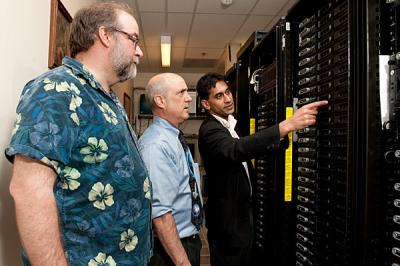ACADEMIA
Patel recognized with NSF Career Award for supercomputer-modeling research on cell membranes
Sandeep Patel, assistant professor in the Department of Chemistry and Biochemistry at the University of Delaware, has received a prestigious Faculty Early Career Development Award from the National Science Foundation (NSF) to support his research using novel supercomputer modeling methods to study the biophysics of model cell membranes, with particular focus on cell-penetrating peptides.
The award also will support the purchase of a computer cluster for Newark (Del.) High School and the development of a new computational-chemistry course to be offered there. Plans call for the course to be team-taught by Patel and two veteran high school science teachers, Stewart Dotts and Robert McDowell, who hope to offer the class in fall 2013.
The highly competitive NSF Career Award recognizes junior faculty members for their role as teacher-scholars and is given to those scientists and engineers considered most likely to become the academic leaders of the 21st century.
"All of our bodies are composed of cells, and between the inside and outside of a cell is what one can loosely consider a barrier, the cell membrane," Patel said in explaining the foundation of his research. "Certain types of molecules—hydrophilic, or 'water-loving,' small molecules and highly charged peptides—can be observed in the membrane, moving very quickly through it, even though it's a very unfavorable environment for them."
There is evidence in the literature, Patel said, suggesting that the transfer of these molecules occurs in the absence of any energy-coupled pathways—in other words, without any help. "This is a rather non-intuitive behavior for such chemical species, and has garnered attention from experimentalists, computational chemists and theorists," Patel said.
In seeking to understand this phenomenon, his group is using supercomputer modeling of interactions between individual atoms to obtain atomic-level insights into how various chemical species support such processes.
The short-term goal of the research is to gain a better understanding of the widely debated mechanisms of this ostensibly non-intuitive behavior of polar molecules, peptides and proteins in cell membranes, and in particular, understand the role of water in this process, Patel said.
Longer-term applications, he said, might be to use cell-penetrating peptides as a way to deliver drugs to the cells, either by themselves, or in conjunction with other platforms such as nanomaterials, research that is currently being pursued in numerous laboratories.
In addition to supporting research, the NSF grant will fund Patel's proposal to engage high school students in science and show them the importance and usefulness of learning about a variety of STEM (science, technology, engineering and mathematics) disciplines. By reaching out to high school students, Patel said, he hopes to interest them in various science disciplines, technology and math even before they arrive on a college campus and to demonstrate how scientific problems can often be solved only by using knowledge from many different disciplines.
At Newark High School, biology and environmental science teacher McDowell and chemistry and physics teacher Dotts will be working with Patel to develop the curriculum for the new course. A feature will be its use of supercomputer modeling, with the NSF grant funding new equipment for the school.
"This project fits right in with the importance that's being placed on STEM, and it will allow kids to see that the various disciplines are all part of it," McDowell said. "That's the message we want to give students—that science is a big, broad field and all its parts are interrelated."
Having a course with University involvement and a co-teacher like Patel who conducts actual research using supercomputers will be a benefit in engaging high school students, Dotts said. "I feel that anything we can do to bring more kids into science classes is a good thing," he said.
The teachers, who have volunteered their time to work on the project, and Patel plan to start developing the course over the summer and to purchase the Newark High supercomputer cluster during the next school year.

